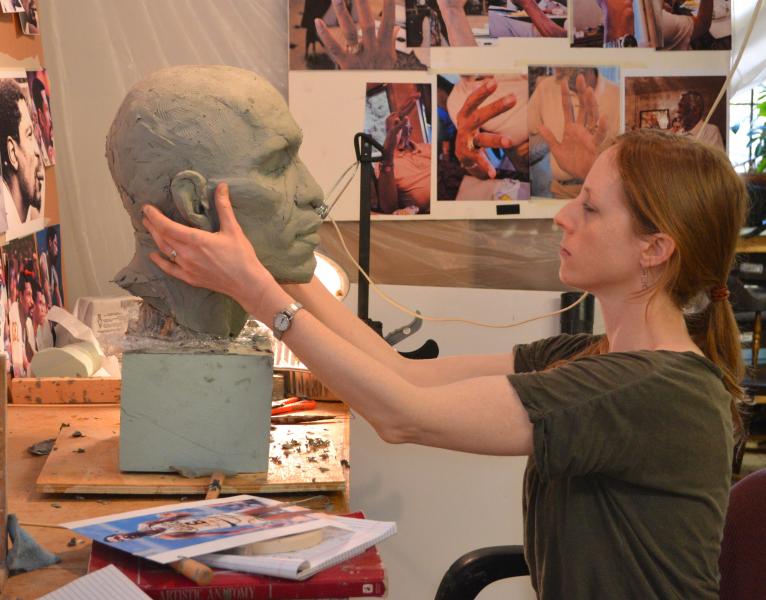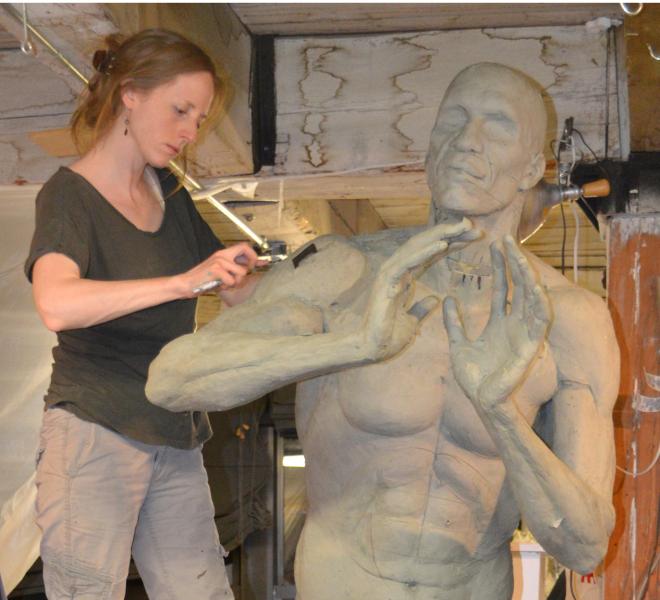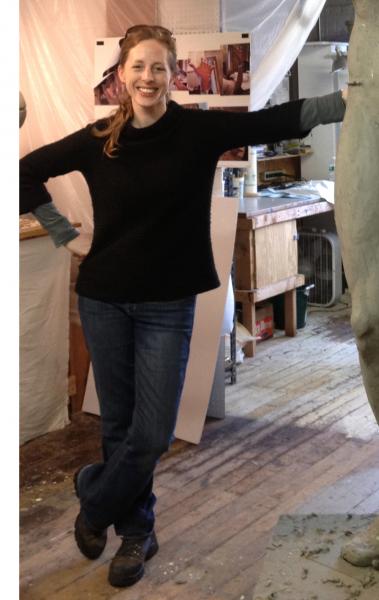In late 2013, Boston City Hall Plaza will unveil a long-awaited addition to its collection of public art: a sculpture honoring Bill Russell, one of Boston’s most prominent and game-changing citizens. In addition to his incredible time as a player and captain with the Boston Celtics, Russell was also the first African-American head coach of a national sports team. His accomplishments are not confined to the court: Bill Russell is also a founding board member of MENTOR: The National Mentoring Partnership, dedicated furthering youth mentoring across the U.S., as well as a noted human rights activist. In 2011, he was awarded the Presidential Medal of Freedom by President Barack Obama.
It is a daunting task to memorialize the contributions of such a multi-dimensional man, especially one that has made such a lasting impact on the Boston community. We are thrilled to have Ann Hirsch, talented figurative sculptor and art educator, as the driving force behind this exciting new public artwork. She is joined by the Cambridge-based landscape architecture firm Pressley Associates in designing a site-specific piece that responds to the unique character of City Hall Plaza. In addition to the creation of a statue honoring Russell’s achievements, The Bill Russell Legacy Project and the Boston Celtics Shamrock Foundation have created a grant program in Russell’s name that will help expand the scope of mentoring projects in the city of Boston. In its inaugural year, the Bill Russell Mentoring Grant has awarded over 50k to local organizations, carrying on Russell’s passion for supporting and nurturing future generations. Russell’s commitment to mentorship will also be mirrored in phase two of the statue, in which artist Ann Hirsch will invite young local students into her studio, working with them to create bronze figures of children that will be displayed on plinths adjacent to the statue of Bill Russell. The public unveiling of the Bill Russell Legacy Project will take place on City Hall Plaza on November 1st, from 2pm-4pm.

In early October of this year, staff members at the Boston Art Commission had the opportunity to ask Ann Hirsch several questions in an effort to gain insight into her creative process as well as her experience working on this groundbreaking project. We have included an excerpt of the conversation below:
Boston Art Commission: Why did you feel it was important to echo the brutalist architecture of City Hall and the surrounding plaza in your design?
Ann Hirsch: We experience public art in a broader historical, spatial and social context and that context, the site, conditions how we encounter and move around public art. The site will always incorporate itself into the experience of a public artwork so it needs to be a part of the design process. In the Bill Russell Legacy Project, City Hall and the surrounding Plaza have been at the forefront of our approach since the beginning. We also felt strongly that our work should stand the test of time and that maintenance considerations should be minimal, so we chose bronze and granite as the best materials for this project due to their longevity and consistency with other materials used on City Hall Plaza.
BAC: What was the biggest challenge in creating the design, and how did you overcome it?
AH: The overriding challenge in this project has been to humanize a space that is dominated by the monumental architecture of City Hall and the vast openness of the surrounding plaza. Architects Kallman, McKinnell and Knowles had the building constructed with precast concrete blocks. The design of the Bill Russell Project embraces the precast units by separating them out and placing them at ground level in order to transform the blocks into plinths for visitors to stand or sit on. Plinths are often what we find sculptures of celebrated figures placed on top of in public spaces but here they are meant to be places for visitors to occupy.
City Hall’s blocks seem to ignore visitors to the site but the plinths invite and uplift them so that the artwork is a celebration of Bill Russell as well as of the potential in each one of us to become 'a champion'. Mayor Menino once said that this part of the Plaza "might be a plaza of champions in the future...but we want to make sure that Bill Russell is the lead champion.” We hope to see this happen along with the realization of this area of the Plaza's full potential to become a lively and welcoming place to gather.
The plinths are disbursed in a field that has the same length-width ratio as a basketball court. There are 10 plinths, one for every player on the court (with the sculpture of Bill Russell, there are 11 elements in all, one for each of his championships). In order to experience the whole artwork, visitors need to move around and through the field of plinths; like a basketball court, it is a forum for interaction. It is appropriate that the conceptual experience of the artwork is arrived at through a physical interaction because one of the primary messages of the work, along with celebrating Bill Russell and teamwork, is to inspire change through mentorship. You get in the game and become a member of Bill Russell's team when you visit the site and interact with the plinths. It becomes a "Plaza of Champions".
BAC: How did you end up choosing what Bill Russell would be wearing in the statue?
AH: We chose to represent Bill Russell as he appeared between the years 1966 – 1969 when he was a player-coach for the Celtics, the first African American coach in the NBA and by most measures, of any major professional sport. Because so many of us know Bill Russell first as the great Celtics legend, we decided that it was important to represent Bill Russell in his Celtics uniform, in the particular style worn then in the NBA so that the sculpture’s historical reference would be clear. The pose is important to notice too: the Russell sculpture is about to make a move called "a chest pass," which is a short throw to a teammate nearby. He is about to throw the ball to an open plinth in front of him, but if you look at his position on the court of the artwork, he has a clear shot to where the net would be and yet he isn't taking the shot. Instead he is throwing the ball to a teammate.

BAC: Did you meet with Bill Russell while generating the design? What was he like? Did he share his thoughts about your design with you?
Ann Hirsch: I met Mr. Russell at his home in Seattle last winter. His daughter Karen Kenyatta Russell and the Boston Celtics Shamrock Foundation arranged for me to visit with him in preparation for the sculpture. Originally it was going to be a lunch meeting but we got to talking and the next thing I knew it was dinnertime. I had wound up spending most of the day with Mr. Russell and his family and it was one of the greatest experiences of my life. Mr. Russell told me stories about the challenges his parents and grandparents faced as African Americans in Louisiana, about how hard they worked, and about the beliefs they instilled in him about responsibility and integrity. We talked about his move at 9 years of age from West Monroe, LA to West Oakland, CA as part of the Great Migration and about his having a daughter who graduated from Harvard Law School. We also talked about what truly remarkable role models Mr. Russell had in the examples of the men in his life, his father and grandfather, and about the support, love and encouragement he had from his parents from a young age. Bill Russell wants everyone, particularly the next generation, to have access to that kind of support, to someone who will believe in him/her because you need that in order to believe in yourself. Karen told me something I’ll never forget: Yao Ming, a great basketball player in recent NBA history, once expressed his gratitude to her father by saying ”How does a blade of grass thank the sun.” That’s a big part of Bill Russell’s Legacy. Mr. Russell has helped so many people along the way and has been a huge supporter of women as well as minorities. We laughed a lot too. Bill Russell is one of the funniest people I've ever met and he seems to enjoy teasing people a little too. He is a great storyteller and a compassionate and generous man. He seemed larger than life to me before I met him and he was even larger afterwards. Mr. Russell did not share his thoughts on the design in particular but there was the general concern that the artwork should not follow the tradition of public art memorials in the design of the sculpture base. For many reasons, but especially this one, we decided to keep the sculpture's base low to the ground and the sculpture, accessible to the public. This sculpture is a place to celebrate and learn about Bill Russell and his legacy: his achievements in basketball, his work in human rights and his dedication to mentorship which is reflected in all of his accomplishments. Bill Russell loves children and this artwork can be an outdoor classroom that invites play and open discussion about Bill Russell’s ideas engraved into the granite plinths.
BAC: What have you enjoyed most about working on the Bill Russell Legacy Project?
AH: Next to meeting Mr. Russell and his children, working as part of a big team to make this project happen has been the most fun. Bill Russell's approach to teamwork on and off the court is one of the aspects of his legacy we celebrate most in this artwork and building this project required a whole lot of teamwork! The Russell family, The Boston Celtics Shamrock Foundation, Steve Pagliuca and the whole Bill Russell Legacy Project Committee with Bobby Sager and Tommy Heinsohn, the Boston Art Commission and the Mayor's Office have been an All-Star team of teamplayers. The Boston Celtics Shamrock Foundation supports so many kids around the City through so many different channels, I feel fortunate to be a part of their work. It has been a true honor and a pleasure to work with the great landscape architecture firm of Pressley Associates and Bill Pressley in particular. Pressley’s expertise with the site and the entire area are unparalleled and I can’t imagine having had a better teammate. And then there are our many fabrication partners, especially Valleay Crest, LeMessurier Consultants, Coldspring, Verne Norman Associates and New England Sculpture Service Foundry right here in Chelsea. Also, at this exciting moment for public art in Boston, working with the Boston Art Commission and especially with Director Karin Goodfellow has been affirming and rewarding at every turn.

For more information on the Bill Russell Legacy Project, visit www.billrusselllegacy.org.
For images and information about sculptor Ann Hirsch, visit http://annhirschstudio.com
____________________________________________________________________________________________

